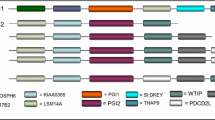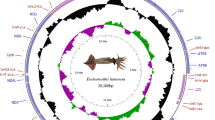Abstract
Insertions and deletions in gene sequences have been used as characters to infer phylogenetic relationships and, like any character, the information they contain varies in utility between different levels of evolution. In one case, the absence of two otherwise highly conserved deletions in the enolase genes of parabasalian protists has been interpreted as a primitive characteristic that suggests these were among the first eukaryotes. Here, semi-environmental 3′-RACE was used to sample enolases from parabasalia in the hindgut of the termite Zootermopsis angusticolis to examine the conservation of this character within the parabasalia. Parabasalian homologues were found to be polymorphic for these deletions, and the phylogeny of parabasalian enolases shows that the deletion-possessing genes branch within deletion-lacking genes (i.e., they did not form two clearly distinct groups). Phylogenetic incongruence was detected in the carboxy-terminal third of the sequence (in the region of the deletions), but there is no unambiguous evidence for recombination. The polymorphism of this character discredits these deletions as strong evidence for the early origin of parabasalia, although the complex distribution makes it impossible to state whether parabasalian enolases were ancestrally like those of other eukaryotes. These observations stress the importance of strong corroborating evidence when considering insertion and deletion data, and raises some interesting questions about the apparent variation in degree of conservation of these deletions between different eukaryotic groups.
Similar content being viewed by others
References
JM Archibald AJ Roger (2002a) ArticleTitleGene conversion and the evolution of euryarchaeal chaperonins: A maximum likelihood-based method for detecting conflicting phylogenetic signals. J Mol Evol 55 232–245 Occurrence Handle10.1007/s00239-002-2321-5 Occurrence Handle1:CAS:528:DC%2BD38XmtFejtbo%3D
JM Archibald AJ Roger (2002b) ArticleTitleGene duplication and gene conversion shape the evolution of archaeal chaperonins. J Mol Biol 316 1041–1050 Occurrence Handle10.1006/jmbi.2002.5409 Occurrence Handle1:CAS:528:DC%2BD38Xhs1yksb8%3D
JM Archibald D Longet J Pawlowski PJ Keeling (2002) ArticleTitleA novel polyubiquitin structure in Cercozoa and Foraminifera: Evidence for a new eukaryotic supergroup. Mol Biol Evol 20 62–66 Occurrence Handle10.1093/molbev/msg006
JM Archibald D Longet J Pawlowski PJ Keeling (2004) ArticleTitleActin and ubiquitin protein sequences support a cercozoan/foraminiferan ancestry for the plasmodiophorid plant pathogens. J Eukaryot Microbiol 51 113–118 Occurrence Handle1:CAS:528:DC%2BD2cXitleit7c%3D Occurrence Handle15068273
SL Baldauf (2003) ArticleTitleThe deep roots of eukaryotes. Science 300 1703–1706 Occurrence Handle10.1126/science.1085544 Occurrence Handle1:CAS:528:DC%2BD3sXksVKisb4%3D Occurrence Handle12805537
SL Baldauf WF Doolittle (1997) ArticleTitleOrigin and evolution of the slime molds (Mycetozoa). Proc Natl Acad Sci USA 94 12007–12012 Occurrence Handle10.1073/pnas.94.22.12007 Occurrence Handle1:CAS:528:DyaK2sXntFSmsb8%3D Occurrence Handle9342353
SL Baldauf JD Palmer (1993) ArticleTitleAnimals and fungi are each other’s closest relatives: Congruent evidence from multiple proteins. Proc Natl Acad Sci USA 90 11558–11562 Occurrence Handle8265589
SL Baldauf JD Palmer WF Doolittle (1996) ArticleTitleThe root of the universal tree and the origin of eukaryotes based on elongation factor phylogeny. Proc Natl Acad Sci USA 93 7749–7754 Occurrence Handle10.1073/pnas.93.15.7749 Occurrence Handle1:CAS:528:DyaK28XksFSrtr0%3D Occurrence Handle8755547
SL Baldauf AJ Roger I Wenk-Siefert WF Doolittle (2000) ArticleTitleA kingdom-level phylogeny of eukaryotes based on combined protein data. Science 290 972–977 Occurrence Handle10.1126/science.290.5493.972 Occurrence Handle1:CAS:528:DC%2BD3cXnvVWksL0%3D Occurrence Handle11062127
E Bapteste H Philippe (2002) ArticleTitleThe potential value of indels as phylogenetic markers: Position of trichomonads as a case study. Mol Biol Evol 19 972–977 Occurrence Handle1:CAS:528:DC%2BD38Xks1Ojurs%3D Occurrence Handle12032255
JR Brown WF Doolittle (1995) ArticleTitleRoot of the universal tree of life based on ancient aminoacyl-tRNA synthetase gene duplications. Proc Natl Acad Sci USA 92 2441–2445 Occurrence Handle1:CAS:528:DyaK2MXksl2ktbw%3D Occurrence Handle7708661
WJ Bruno ND Socci AL Halpern (2000) ArticleTitleWeighted neighbor joining: A likelihood-based approach to distance-based phylogeny reconstruction. Mol Biol Evol 17 189–197 Occurrence Handle1:CAS:528:DC%2BD3cXot1Sisg%3D%3D Occurrence Handle10666718
TM Embley RP Hirt (1998) ArticleTitleEarly branching eukaryotes? Curr Opin Genet Dev 8 624–629 Occurrence Handle10.1016/S0959-437X(98)80029-4 Occurrence Handle1:CAS:528:DyaK1MXhs1yjtQ%3D%3D Occurrence Handle9914207
J Felsenstein (1993) PHYLIP (phylogeny inference package). University of Washington Seattle
D Gerbod E Sanders S Moriya C Noël H Takasu NM Fast P Delgado-Viscogliosi M Ohkuma T Judo M Capron JD Palmer PJ Keeling E Viscogliosi (2004) ArticleTitleMolecular phylogenies of parabasalia inferred from four protein genes and comparison with rRNA trees. Mol Phylogenet Evol . .
V Hannaert H Brinkmann U Nowitzki JA Lee MA Albert CW Sensen T Gaasterland M Muller P Michels W Martin (2000) ArticleTitleEnolase from Trypanosoma brucei, from the amitochondriate protist Mastigamoeba balamuthi, and from the chloroplast and cytosol of Euglena gracilis: Pieces in the evolutionary puzzle of the eukaryotic glycolytic pathway. Mol Biol Evol 17 989–1000 Occurrence Handle1:CAS:528:DC%2BD3cXksVOmu7w%3D Occurrence Handle10889212
T Hashimoto Y Nakamura F Nakamura T Shirakura J Adachi N Goto K Okamoto M Hasegawa (1994) ArticleTitleProtein phylogeny gives a robust estimation for early divergences of eukaryotes: Phylogenetic place of a mitochondria-lacking protozoan, Giardia lamblia. Mol Biol Evol 11 65–71 Occurrence Handle1:CAS:528:DyaK2cXhsFymsbk%3D Occurrence Handle8121287
T Kamaishi T Hashimoto Y Nakamura F Nakamura S Murata N Okada K-I Okamoto M Shimzu M Hasegawa (1996) ArticleTitleProtein phylogeny of translation elongation factor EF-1α suggests Microsporidians are extremely ancient eukaryotes. J Mol Evol 42 257–263 Occurrence Handle1:CAS:528:DyaK28XitFSrsro%3D Occurrence Handle8919877
PJ Keeling (2001) ArticleTitleForaminifera and Cercozoa are related in actin phylogeny: Two orphans find a home? Mol Biol Evol 18 1551–1557 Occurrence Handle1:CAS:528:DC%2BD3MXlslOis7Y%3D Occurrence Handle11470846
PJ Keeling NM Fast (2002) ArticleTitleMicrosporidia: Biology and evolution of highly reduced intracellular parasites. Annu Rev Microbiol 56 93–116 Occurrence Handle10.1146/annurev.micro.56.012302.160854 Occurrence Handle1:CAS:528:DC%2BD38Xos1Gis74%3D Occurrence Handle12142484
PJ Keeling BS Leander (2003) ArticleTitleCharacterisation of a non-canonical genetic code in the oxymonad Streblomastix strix. J Mol Biol 326 1337–1349 Occurrence Handle10.1016/S0022-2836(03)00057-3 Occurrence Handle1:CAS:528:DC%2BD3sXht1Gjsb4%3D Occurrence Handle12595248
PJ Keeling JD Palmer (2000) ArticleTitleParabasalian flagellates are ancient eukaryotes. Nature 405 635–637 Occurrence Handle1:CAS:528:DC%2BD3cXktlCju7k%3D
PJ Keeling JD Palmer (2001) ArticleTitleLateral transfer at the gene and subgenic levels in the evolution of eukaryotic enolase. Proc Natl Acad Sci USA 98 10745–10750 Occurrence Handle10.1073/pnas.191337098 Occurrence Handle1:CAS:528:DC%2BD3MXntVGms70%3D Occurrence Handle11526220
D Longet JM Archibald PJ Keeling J Pawlowski (2003) ArticleTitleForaminifera and Cercozoa share a common origin according to RNA polymerase II phylogenies. Int J Syst Evol Microbiol . .
H Philippe A Adoutte (1998) The molecular phylogeny of eukaryota: solid facts and uncertainties. GH Coombs K Vickerman MA Sleigh A Warren (Eds) Evolutionary relationships among protozoa. Chapman & Hall London 25–56
MC Rivera JA Lake (1992) ArticleTitleEvidence that eukaryotes and eocyte prokaryotes are immediate relatives. Science 257 74–76 Occurrence Handle1:CAS:528:DyaK38XlsVGksrc%3D Occurrence Handle1621096
AG Simpson AJ Roger (2002) ArticleTitleEukaryotic evolution: Getting to the root of the problem. Curr Biol 12 R691–R693 Occurrence Handle10.1016/S0960-9822(02)01207-1 Occurrence Handle1:CAS:528:DC%2BD38Xot1agsrs%3D Occurrence Handle12401185
ML Sogin (1991) ArticleTitleEarly evolution and the origin of eukaryotes. Curr Opin Genet Dev 1 457–463 Occurrence Handle1:CAS:528:DyaK38Xht1egtrw%3D Occurrence Handle1822277
A Stechmann T Cavalier-Smith (2002) ArticleTitleRooting the eukaryote tree by using a derived gene fusion. Science 297 89–91 Occurrence Handle10.1126/science.1071196 Occurrence Handle1:CAS:528:DC%2BD38XltFGntrw%3D Occurrence Handle12098695
K Strimmer A von Haeseler (1996) ArticleTitleQuartet puzzling: A quartet maximum-likelihood method for reconstructing tree topologies. Mol Biol Evol 13 964–969 Occurrence Handle1:CAS:528:DyaK28XltlSmsLk%3D
W Trager (1934) ArticleTitleThe cultivation of a cellulose-digesting flagellate, Trichomonas termopsidis, and of certain other termite protozoa. Biol Bull 66 182–190
MA Yamin (1979) ArticleTitleFlagellates of the orders Trichomonadida Kirby, Oxymonadida Grassé, and Hypermastigida Grassi & Foà reported from lower termites (Isoptera Falilies Mastotermitidae, Kalotermitidae, Hodotermitidae, Termopsidae, Rhinotermitidae, and Serritermididae) and from the wood-feeding roach Cryptocercus (Dictyoptera:Ceyptocercidae). Sociobiology 4 1–120
Author information
Authors and Affiliations
Corresponding author
Rights and permissions
About this article
Cite this article
Keeling, P.J. Polymorphic Insertions and Deletions in Parabasalian Enolase Genes . J Mol Evol 58, 550–556 (2004). https://doi.org/10.1007/s00239-003-2577-4
Received:
Accepted:
Issue Date:
DOI: https://doi.org/10.1007/s00239-003-2577-4




